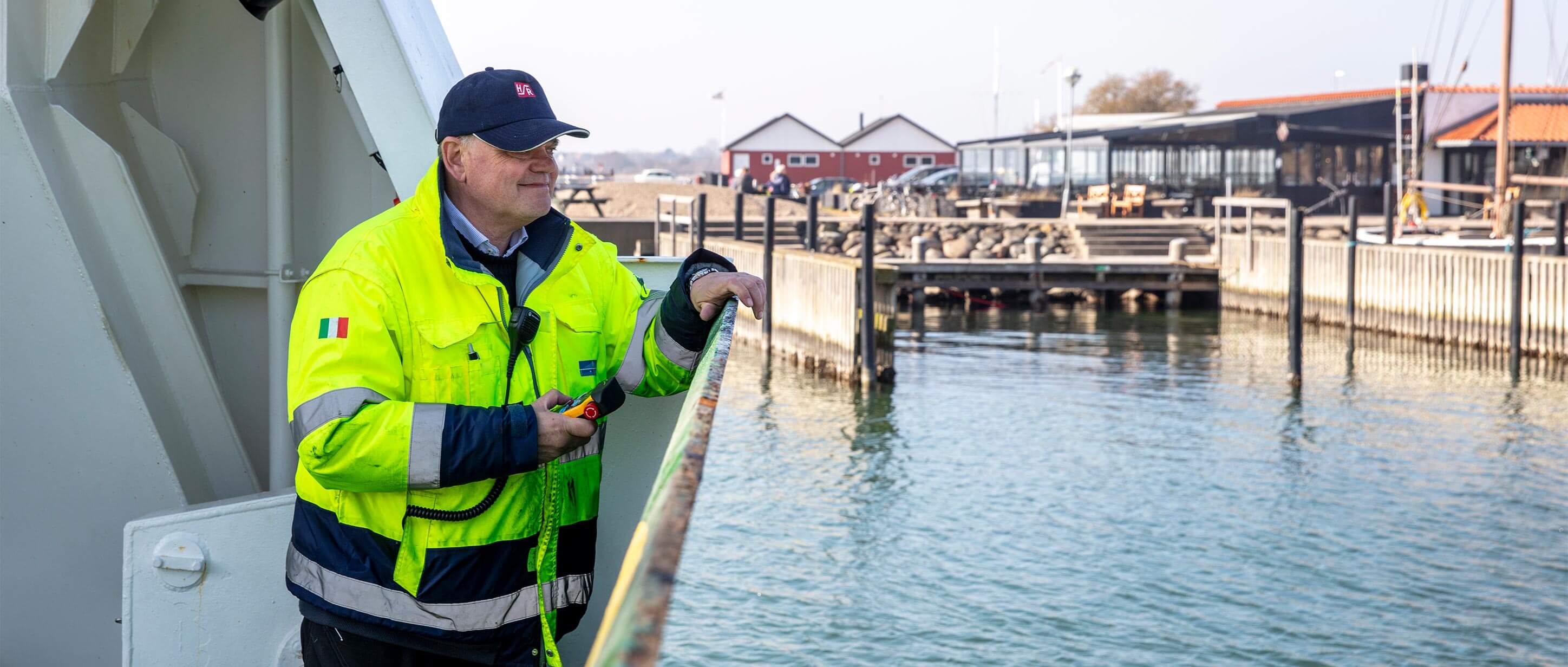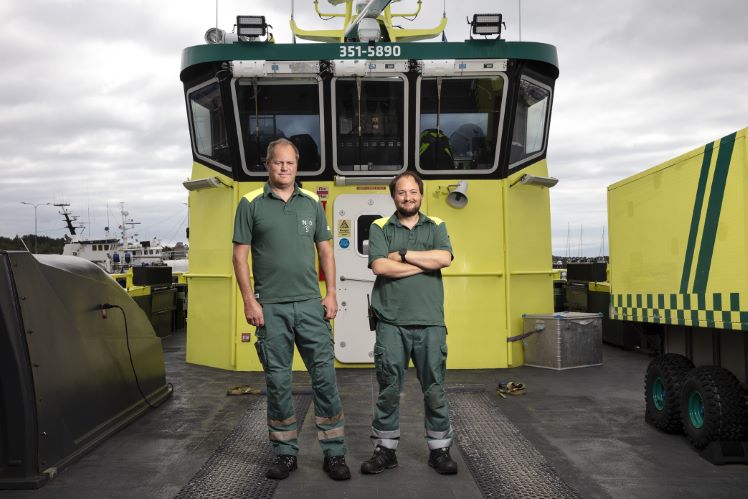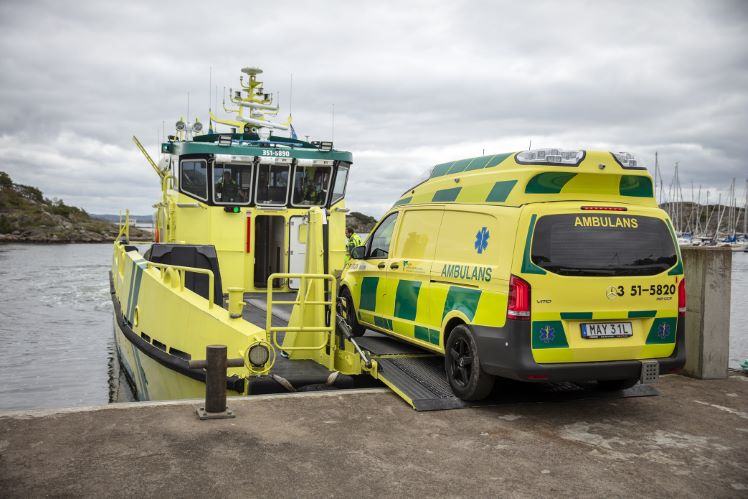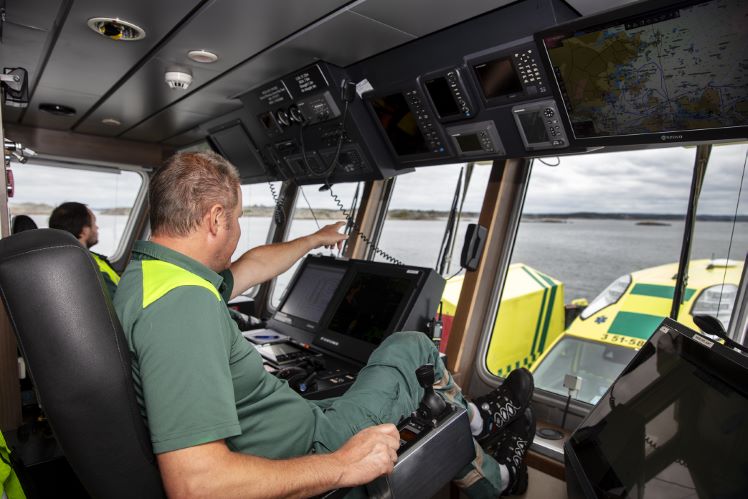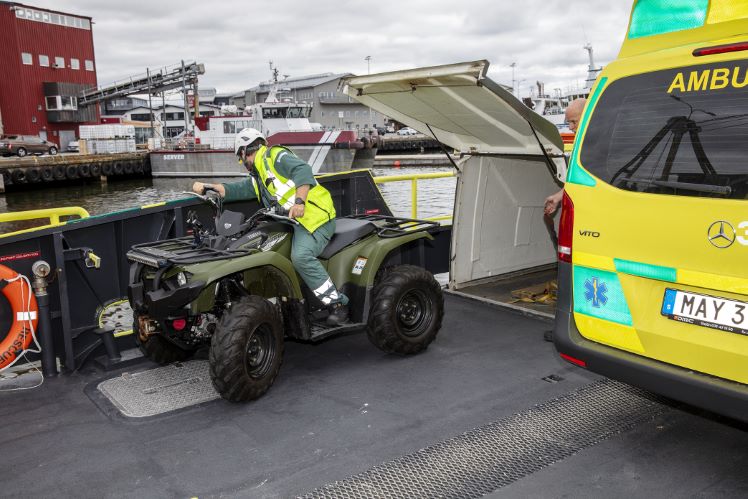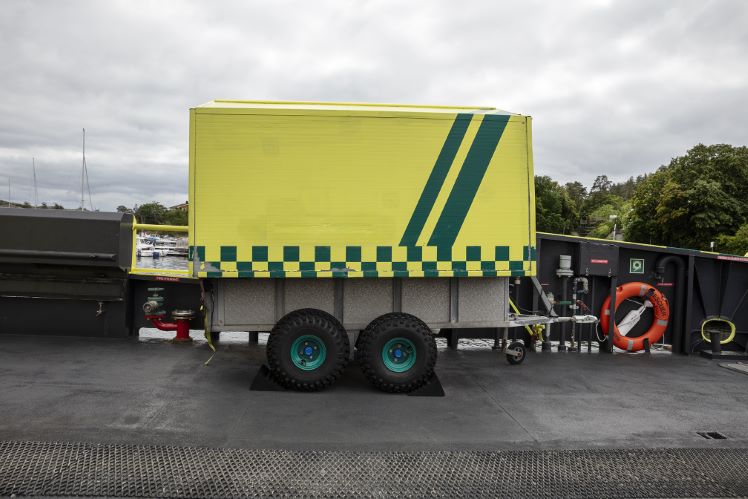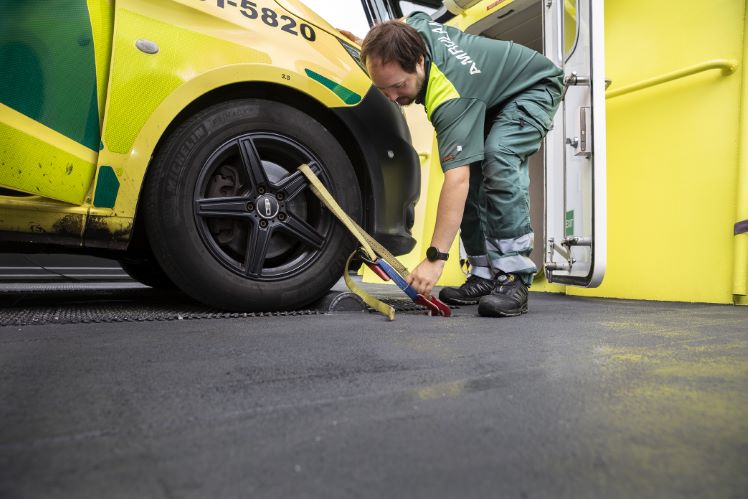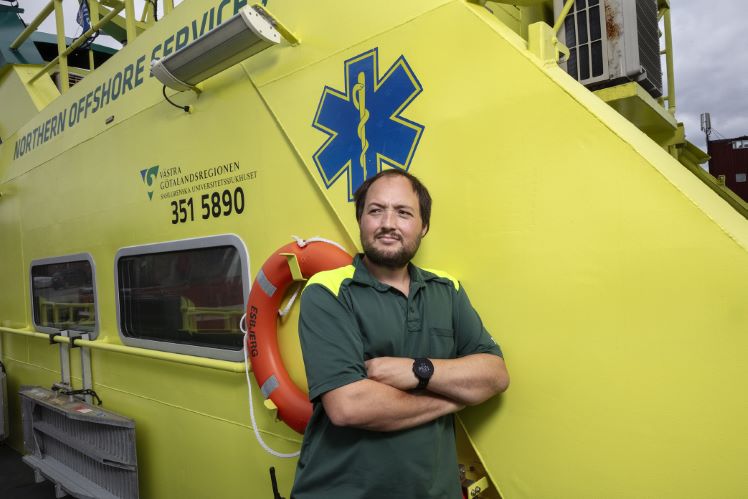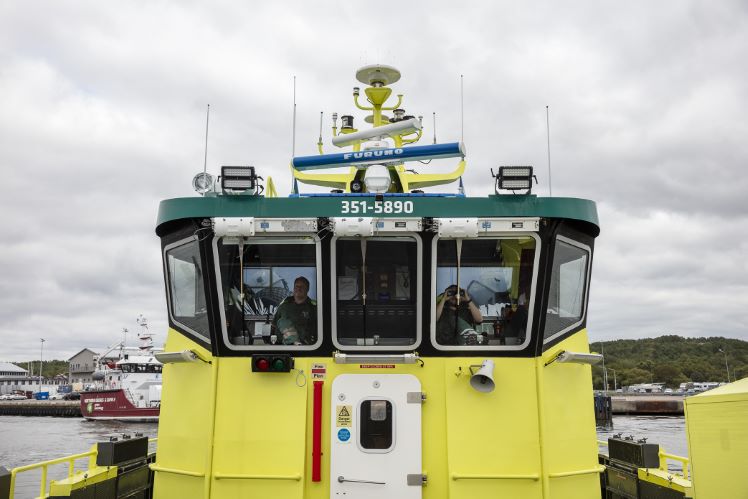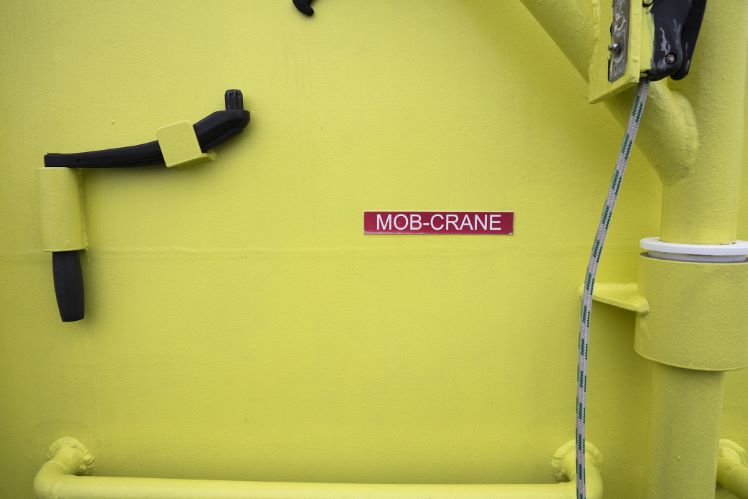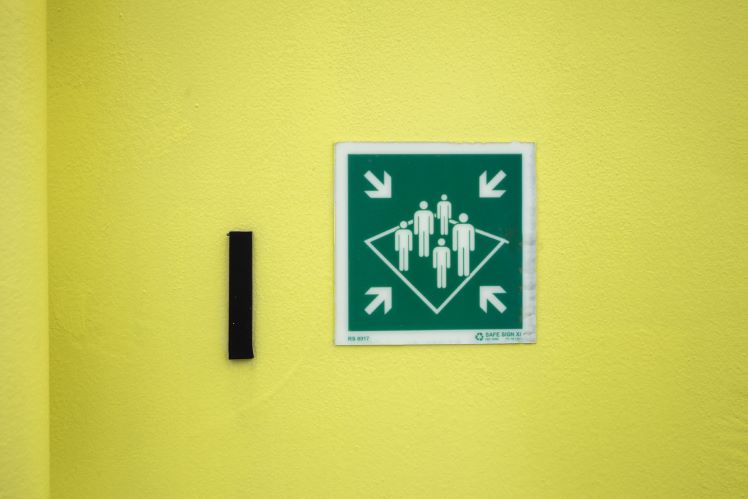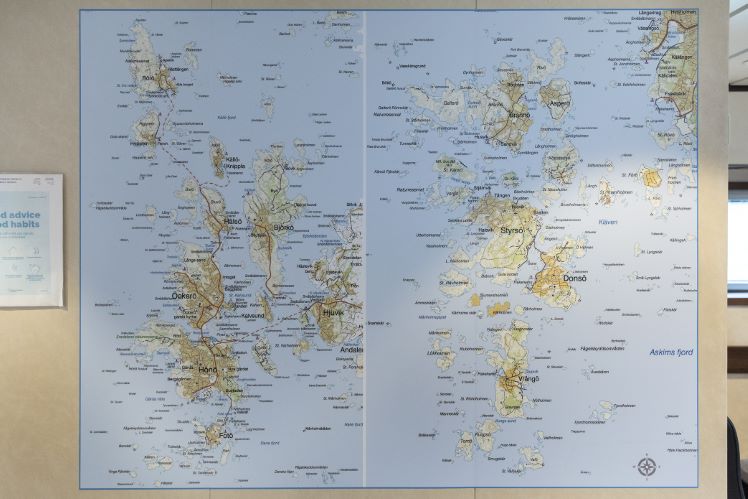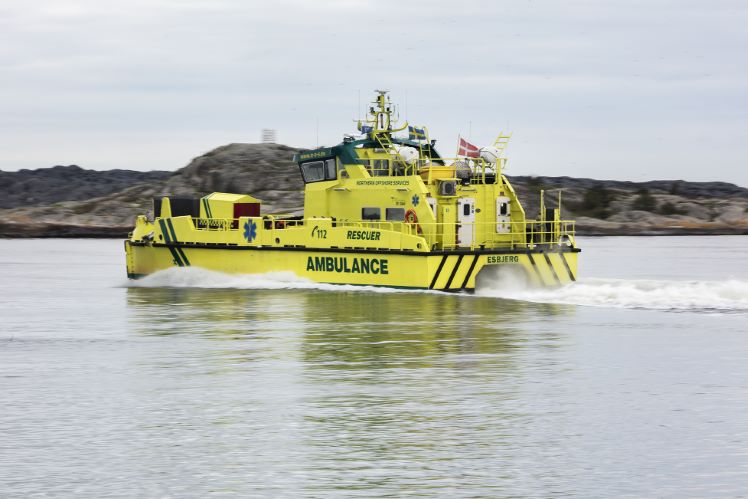Ambulance boat M/V Rescuer is one of a kind in the Nordic region and among very few worldwide. On average, the boat answers two to three alarms a day all year round, and UFDS has joined a couple of the trips, where safety is of course top notch.
It’s pretty unmistakable as UFDS glides into the port on the island of Donsö in the southern part of the Gothenburg archipelago. But with most of the hull painted in characteristic neon yellow, solely interrupted by the words 'Ambulance' and 'Rescuer' as well as the phone number 112, it’s meant to be easy to spot.
UFDS is in southwest Sweden, where shipping company Northern Offshore Services (N-O-S) operates the ambulance boat M/V Rescuer. Out purpose is to learn about daily life on the small but important vessel, and getting an insight into the thoughts the small crew has about safety while working, which you can read about here.
On the docks, we are met by helmsman Henrik Johansson, who leads us aboard the boat, where Captain Niklas Rosengren is ready with coffee and cake – or fika, as they say on the other side of the Oresound. Together, the two make up the crew of the boat, supplemented by Petter and another Nicklas, who man the boat's ambulance – the one on four wheels, that is.
While Henrik gives us a tour of the vessel – which is over fairly quickly compared to the trips back and forth on, for example, Marseille Maersk – he tells us a bit more about how everyday life works for him and his colleague.
»If there's no alarm, we do a morning meeting and plan ahead for the day. We have a schedule so we can see if, for example, we need to clean a little, who handles catering and so on. And often the medics will check their car and medicine while we take care of the ship,« he explains.
On average, Rescuer has two to three alarm calls a day, so it is rarely a problem for the staff on board to get enough rest. But when you are on duty around the clock every day of the year, you have to be ready. ‘We can't just park the boat and lie down for 12 hours; then someone dies', as Henrik dryly notes.
36-year-old Henrik Johansson is a trained master, while Niklas Rosengren, 44, is a coastal skipper. Between them, the two can muster around 20 years of experience at sea, and especially the latter boasts an in-depth knowledge of the islands in the region, having not only patrolled the waters with Rescuer since it was put into operation in 2015, but also grown up and still resides.
90 percent of the assignments are in the southern part of the archipelago, especially around the base on Donsö, where N-O-S was founded, and the neighboring island of Styrsö. As an exception in the area, the two islands are linked together by a bridge, but the small communities are otherwise quite isolated and therefore also dependent on Rescuer’s services in case of accidents or acute illness.
Full speed – conditions permitting
While serving the permanent inhabitants of the islands is Rescuer's primary task, the vessel only on very rare occasions take part in actual sea rescue, which is left to the coast guard or local pilot service. These units receive emergency calls on the VHF band and can contact emergency services if necessary.
»We take up quite a lot of space on the small islands where people bathe of the rocks. This boat is built to dock at berths, as the slightly larger built-up islands have, so that's our focus,« Henrik Johansson, a five year veteran on Rescuer, says.
In rare cases – on average about five times a year according to Henrik Johansson – a helicopter can be called, but since it’s the only one in the region, the risk of it being 200 kilometers away on, for example, a car accident, means Rescuer that is the primary resource in the area.
Even when lives are at stake and the boat needs to move at speed, it is still with safety in mind. Especially during the summer months, tempo must be adjusted to the conditions, often offering piles of small boats in the narrow navigation channels that need time to move.
»When we started sailing, we didn't have a siren on the boat, so we could only warn people with lights, and no one really noticed that. So, we had a siren installed, and then people started moving, just like on land. On the other hand we have no interest in stressing them out causing accidents, so it's a balance,« Niklas Rosengren says.
After more than eight years of operation in the area, Rescuer are well known to other sailors – and vice versa – so everyone knows what is happening when the blue lights are flashing. In other words: people move. And when the siren is off, the Rescuer gives way to others.
Quad bike with own garage on deck
Both Henrik and Niklas are happy with their job, but at the same time acknowledge that it comes with a price tag. Although none of them would label the job hard as such, it is none the less demanding that the officers on duty must be available 24 hours a day.
»The alarm can go off in the middle of the night, you have to get up, get your game on and sail safely. You have to make the right decisions and the margins are very small; Three meters in the wrong direction, then you sit on a rock and there are small boats and tourists in the summer. You have to be ready,« Niklas Rosengren says.
In order to navigate safely around the narrow and often heavily trafficked shipping lanes, Niklas and Henrik employ what the latter calls ‘an active pilot/co-pilot collaboration’ on the bridge, allowing the two of them to control what is happening around the vessel and simultaneously handle communication with, for example, the many small passenger ferries connecting the islands to the mainland.
On top of this, Rescuer is equipped with a handful of CCTV cameras monitoring the deck and its immediate surroundings, feeding live images to the bridge.
In addition to the hustle and bustle, there is also quite a bit of waiting associated with sailing an ambulance boat. Partly the 'downtime' on Donsö, when there are no alarms, but also while the ambulance is ashore, whether on an island or while a patient is being taken to the hospital in Gothenburg.
If circumstances deem it necessary to carry more than one patient, the Rescuer itself is also equipped with a stretcher, first aid equipment and the like similar to a regular ambulance. However, it is not something that is in use very often, Henrik Johansson notes.
The stretcher and other medical equipment are located in the central compartment of the Rescuer, which also stores, among other things, life jackets, various medications, dressings and medical equipment, as well as a couple of electric bikes for transportation on the smallest islands, where the roads – or rather paths – aren’t big enough for the ambulance.
To this end, the Rescuer also has a quad bike parked on the front deck, as of recently in its own small garage in the shape of a plastic box shielding the vehicle from salt water, wind and weather. When the time comes, Henrik drives the crosser, to which an enclosed trailer is attached offering space for rescuers, stretcher, and necessary equipment.
In addition to the crosser, Henrik Johansson also points to the ship's assembly station on the port side, followed by instructions on what we as guests should do – and especially not do – in the likely event of an alarm.
UFDS also gets a quick look in the engine room on the port side – starboard is similar, only mirrored – where, despite cramped conditions, there is ample room for both a small workshop, a 3,000-liter diesel tank, which together with the corresponding one on the other side provides fuel for about a week, maybe 10 days of operation depending on the level of activity, and of course main and auxiliary engines, water treatment etc.
Danish flag causes wonder
Just as UFDS together with Henrik Johansson reaches to back of the engine, inevitably the alarm goes off, leaving us no choice but to twist our way back up and get the boat going. Keeping in line with their own recommendations, both Henrik and Niklas make sure that things happen at the right pace without stress.
The alarm is in category 2, i.e., the second most serious, and the call comes from the neighboring island of Styrsö, leading to the immediate decision that the ambulance will be able to cross faster by driving on its own across the bridge spanning roughly 150 meters between the islands.
After the ambulance has left, Rescuer slides out of the ferry berth on Donsö, navigating under the aforementioned bridge and at a leisurely pace into the small port on Styrsö, where Niklas Rosengren effortlessly pushes the bow towards the quay. In such situations, the crew doesn’t moor the boat, but simply lower the ramp and keep the engine running while waiting for the ambulance to return.
This happens after just over 20 minutes, after which we now – at slightly higher speeds, but lights turned off – head for Fiskebäck on the mainland, where the patient is undramatically transferred to a waiting ambulance and taken on to the hospital.
»It was nice that we got a call. Often when we have students on board to learn something about either the medical or the maritime aspects, nothing happens for two days, so this was a nice trip,« says Henrik Johansson with a smile as we return to base.
Before reaching the berth on Donsö, the alarm goes off again, but this time on Donsö itself, so Rescuer docks and once again unloads the ambulance. Then we head back to Styrsö, cutting the distance to land shorter in case the patient needs to move on to the hospital.
While we – again – wait for the ambulance in the port of Styrsö, Niklas and Henrik share a few more insights on daily life aboard the only ambulance boat in the Nordic region, and one of very few worldwide. That status – and the eye-catching exterior – makes the M/V Rescuer a bit of an attraction in itself.
»We get quite regular visits by interested people from other shipping companies and cities, and also journalists who want to hear about what we do, and we are probably also the most photographed boat in the entire region. Every time we pass a ferry or dock somewhere, we can see how cameras are pointed in our direction,« Niklas Rosengren says, clearly not entirely dissatisfied with the situation.
In addition to being a photo model (from a distance at least), he has gotten quite experienced when it comes to answering the by far most frequent question the crew of the Rescuer is asked.
»A lot of people wonder why we are Danish-flagged when we operate around here and have our base on Donsö, but there is a good reason for this, since the shipping company is Danish and the boat is registered in Esbjerg (where the N-O-S office in Denmark used to be, ed.). So, it's not something we think about, but we can appreciate why people think it's a bit strange,« Niklas Rosengren says.
With the ambulance back, and the situation sufficiently acute that the patient must be taken to hospital in Rescuer's own car, the engines are repped up on the way to Fiskebäck. With an hour of waiting after the ambulance has been set ashore, there is time for Rescuer to drop UFDS off at the N-O-S hq, so after two emergency calls with safety in check, we wave our goodbyes to the bright yellow uniqueness in the Swedish archipelago.



